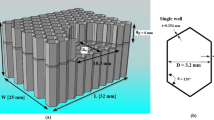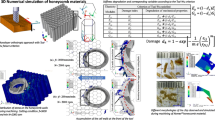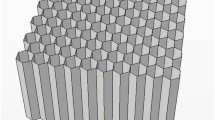Abstract
The use of Nomex honeycomb structures is essential for the aerospace and aeronautics industry because of their high out-of-plane strength and their advantageous weight/rigidity ratio. Nevertheless, milling these structures presents technical and scientific challenges, including premature wear of cutting tools and the quality of the machined surface. In general, the machining process relies on carrying out experimental tests. However, the high rotation speed of the cutting tool makes it difficult to monitor the cutting process correctly. Thus, it has become imperative to adopt reliable numerical models to collect instantaneous and accurate physical data. For this purpose, a 3D finite element numerical model was developed using the Abaqus/Explicit software, taking into account the real conditions of the experiment. An experimental validation was carried out by analyzing the premature wear of the cutting tool. After having validated the numerical model, an in-depth analysis was carried out to evaluate the influence of the number of teeth of the cutting tool on the optimization of the machining of the Nomex honeycomb structure. This analysis specifically focused on the cutting forces, the quality of the machined surface, and the accumulation of chips in front of the cutting tool. The obtained results clearly underline that low feed rates improve the integrity of the cutting tool, while a limited number of cutting tool teeth significantly improves cutting forces and the quality of the machined surface.
















Similar content being viewed by others
Data availability
Not applicable.
Code availability
Not applicable.
References
Foo CC, Chai GB, Seah LK (2007) Mechanical properties of Nomex material and Nomex honeycomb structure. Compos Struct 80(4):588–594. https://doi.org/10.1016/j.compstruct.2006.07.010
Kim DS, Lee JR (1997) Compressive mechanical properties of the nomex/thermoset honeycomb cores. Polym Adv Technol 8(1):1–7. https://doi.org/10.1002/(SICI)1099-1581(199701)8:1%3c1::AID-PAT601%3e3.0.CO;2-G
Li Y (1995) The development and application of the Nomex honeycomb in Russia aerospace area. J Mater Eng 4:3–5
Liu L, Wang H, Guan Z (2015) Experimental and numerical study on the mechanical response of Nomex honeycomb core under transverse loading. Compos Struct 121:304–314. https://doi.org/10.1016/j.compstruct.2014.11.034
Zarrouk T, Nouari M, Makich H (2023) Simulated study of the machinability of the nomex honeycomb structure. J Manuf Mater Process 7(1):28. https://doi.org/10.3390/jmmp7010028
Sharma VK, Singh T, Rana M, Singh K (2022) Multi-output optimization during MQL based face milling of EN-31 steel employing Taguchi coupled grey relational analysis. Mater Today Proc 65:3216–3223. https://doi.org/10.1016/j.matpr.2022.05.376
Devillez A, Lesko S, Mozer W (2004) Cutting tool crater wear measurement with white light interferometry. Wear 256(1–2):56–65. https://doi.org/10.1016/S0043-1648(03)00384-3
El-Wardany TI, Gao D, Elbestawi MA (1996) Tool condition monitoring in drilling using vibration signature analysis. Int J Mach Tools Manuf 36(6):687–711. https://doi.org/10.1016/0890-6955(95)00058-5
Ma K, Wang J, Zhang J, Feng P, Yu D, Ahmad S (2022) A force-insensitive impedance compensation method for giant magnetostriction ultrasonic cutting system of Nomex honeycomb composites. Compos Struct 294:115708. https://doi.org/10.1016/j.compstruct.2022.115708
Nouari M (2000) Modélisation de l’usure par diffusion des outils de coupe en usinage grande vitesse. Université Paul Verlaine-Metz.
Adin MŞ (2023) Performances of cryo-treated and untreated cutting tools in machining of AA7075 aerospace aluminium alloy. Eur Mech Sci 7(2):70–81. https://doi.org/10.26701/ems.1270937
Zarrouk T, Salhi JE, Atlati S, Nouari M, Salhi M, Salhi N (2022) Modeling and numerical simulation of the chip formation process when machining Nomex. Environ Sci Pollut Res 1–8. https://doi.org/10.1007/s11356-021-13736-6
Jaafar M, Atlati S, Makich H, Nouari M, Moufki A, Julliere B (2017) A 3D FE modeling of machining process of Nomex® honeycomb core: influence of the cell structure behaviour and specific tool geometry. Procedia Cirp 58:505–510. https://doi.org/10.1016/j.procir.2017.03.255
Jaafar M, Makich H, Nouari M (2021) A new criterion to evaluate the machined surface quality of the Nomex® honeycomb materials. J Manuf Process 69:567–582. https://doi.org/10.1016/j.jmapro.2021.07.062
Qiu K, Ming W, Shen L, An Q, Chen M (2017) Study on the cutting force in machining of aluminum honeycomb core material. Compos Struct 164:58–67. https://doi.org/10.1016/j.compstruct.2016.12.060
Zarrouk T, Nouari M, Salhi JE, Makich H, Salhi M, Atlati S, Salhi N (2022) Optimization of the milling process for aluminum honeycomb structures. Int J Adv Manuf Technol 1–12. https://doi.org/10.1007/s00170-021-08495-0
Zarrouk T, Salhi JE, Atlati S, Nouari M, Salhi M, Salhi N (2021) Study on the behavior law when milling the material of the Nomex honeycomb core. Mater Today Proc 45:7477–7485. https://doi.org/10.1016/j.matpr.2021.02.110
Zarrouk T, Salhi JE, Nouari M, Salhi M, Chaabelasri E, Makich H, Salhi N (2022) Modeling machining of aluminum honeycomb structure. Int J Adv Manuf Technol 123(7–8):2481–2500. https://doi.org/10.1007/s00170-022-10350-9
Zarrouk T, Salhi JE, Nouari M, Salhi M, Atlati S, Salhi N, Makich H (2021) Analysis of friction and cutting parameters when milling honeycomb composite structures. Adv Mech Eng 13(7):16878140211034840. https://doi.org/10.1177/16878140211034841
Zarrouk T, Salhi JE, Nouari M, Salhi M, Kodad J (2023) Influence of the cutting tool geometry on milling aluminum honeycomb structures. Int J Adv Manuf Technol 126(1–2):313–324. https://doi.org/10.1007/s00170-023-11144-3
Weizhou WU, Shipeng LI, Xuda QIN, Wentao LIU, Xin CUI, Hao LI, Haibao LIU (2023) Effects of fiber orientation on tool wear evolution and wear mechanism when cutting carbon fiber reinforced plastics. Chin J Aeronaut 36(5):549–565. https://doi.org/10.1016/j.cja.2022.09.003
Fischer S, Drechsler K, Kilchert S, Johnson A (2009) Mechanical tests for foldcore base material properties. Compos A Appl Sci Manuf 40(12):1941–1952. https://doi.org/10.1016/j.compositesa.2009.03.005
Seemann R, Krause D (2017) Numerical modelling of Nomex honeycomb sandwich cores at meso-scale level. Compos Struct 159:702–718. https://doi.org/10.1016/j.compstruct.2016.09.071
Roy R, Park SJ, Kweon JH, Choi JH (2014) Characterization of Nomex honeycomb core constituent material mechanical properties. Compos Struct 117:255–266. https://doi.org/10.1016/j.compstruct.2014.06.033
Heimbs S (2009) Virtual testing of sandwich core structures using dynamic finite element simulations. Comput Mater Sci 45(2):205–216. https://doi.org/10.1016/j.commatsci.2008.09.017
Roy R, Nguyen KH, Park YB, Kweon JH, Choi JH (2014) Testing and modeling of Nomex™ honeycomb sandwich Panels with bolt insert. Compos B Eng 56:762–769. https://doi.org/10.1016/j.compositesb.2013.09.006
Jaafar M (2018) Étude expérimentale et simulation numérique de l’usinage des matériaux en nids d’abeilles : application au fraisage des structures Nomex® et Aluminium (Doctoral dissertation, Université de Lorraine)
Chung J, Waas AM (2002) Compressive response of honeycombs under in-plane uniaxial static and dynamic loading, Part 2: Simulations. AIAA J 40(5):974–980. https://doi.org/10.2514/2.1734
Goldsmith W, Louie DL (1995) Axial perforation of aluminum honeycombs by projectiles. Int J Solids Struct 32(8–9):1017–1046. https://doi.org/10.1016/0020-7683(94)00188-3
Kilchert S (2013) Nonlinear finite element modelling of degradation and failure in folded core composite sandwich structures. https://doi.org/10.18419/opus-3932
Heimbs S (2008) Sandwichstrukturen mit Wabenkern: Experimentelle und numerische Analyse des Schädigungsverhaltens unter statischer und kurzzeitdynamischer Belastung (Doctoral dissertation, Dissertation, Kaiserslautern, Technische Universität Kaiserslautern, 2008).
Liu PF, Zheng JY (2008) Progressive failure analysis of carbon fiber/epoxy composite laminates using continuum damage mechanics. Mater Sci Eng A 485(1–2):711–717. https://doi.org/10.1016/j.msea.2008.02.023
Padhi GS, Shenoi RA, Moy SSJ, Hawkins GL (1997) Progressive failure and ultimate collapse of laminated composite plates in bending. Compos Struct 40(3–4):277–291. https://doi.org/10.1016/S0263-8223(98)00030-0
Gemkow K, Vignjevic R (2013) Strain-softening in continuum damage models: Investigation of MAT_058. In 9th European LS-DYNA Conference.
Jenarthanan MP, Jeyapaul R (2013) Optimisation of machining parameters on milling of GFRP composites by desirability function analysis using Taguchi method. Int J Eng Sci Technol 5(4):22–36. https://doi.org/10.4314/ijest.v5i4.3
Zhou X, Gao Y, Wang Y, Xiao P, Huang X (2022) Effects of ZrC particles, load and sliding speed on the wear behavior of the ZrC/2024Al composites. Wear 506:204465. https://doi.org/10.1016/j.wear.2022.204465
Moharami A, Qodosi P (2022) Enhanced dry sliding friction and wear behaviors of Mg–Mg2Si composites. Compos Commun 36:101365. https://doi.org/10.1016/j.coco.2022.101365
Jiang L, Wan Y, Zhang N, Fu J, Li X, Zhang X, Du P (2022) Erosive wear characteristics of styrene butadiene rubber and silicon dioxide-filled wood–plastic composites. J Build Eng 56:104791. https://doi.org/10.1016/j.jobe.2022.104791
Funding
Not applicable.
Author information
Authors and Affiliations
Contributions
TZ performed analyzed and interpreted data and results. MN analyzed and interpreted data and was a major contributor to writing the manuscript. AB analyzed and interpreted data and results. AB was a major contributor to writing the manuscript. All authors read and approved the final manuscript.
Corresponding author
Ethics declarations
Ethics approval and consent to participate
Not applicable.
Consent for publication
Not applicable.
Competing interests
The authors declare that they have no competing interests.
Additional information
Publisher's Note
Springer Nature remains neutral with regard to jurisdictional claims in published maps and institutional affiliations.
Rights and permissions
Springer Nature or its licensor (e.g. a society or other partner) holds exclusive rights to this article under a publishing agreement with the author(s) or other rightsholder(s); author self-archiving of the accepted manuscript version of this article is solely governed by the terms of such publishing agreement and applicable law.
About this article
Cite this article
Zarrouk, T., Nouari, M., Benbouaza, A. et al. Influence of cutting tool geometry when milling Nomex honeycomb structure. Int J Adv Manuf Technol 130, 649–663 (2024). https://doi.org/10.1007/s00170-023-12729-8
Received:
Accepted:
Published:
Issue Date:
DOI: https://doi.org/10.1007/s00170-023-12729-8




